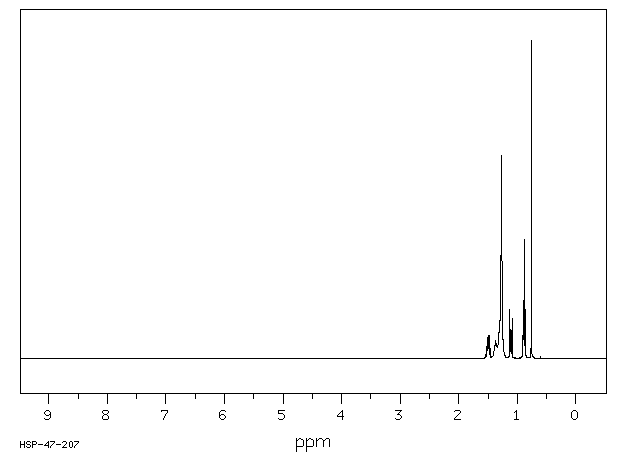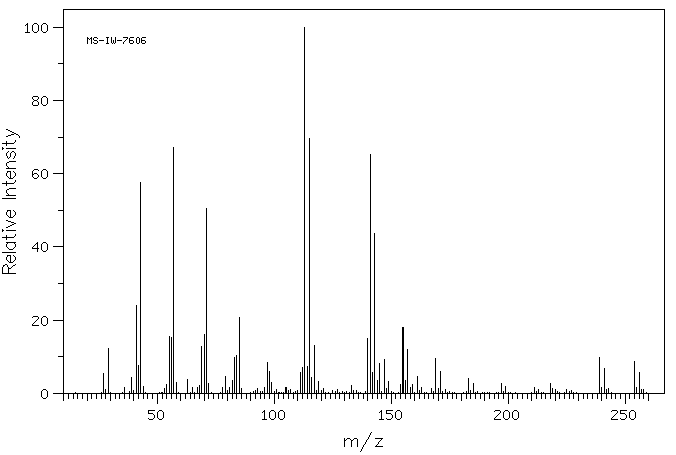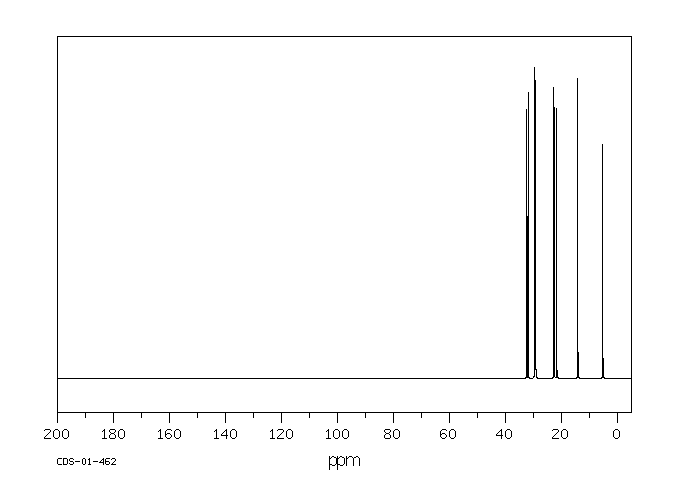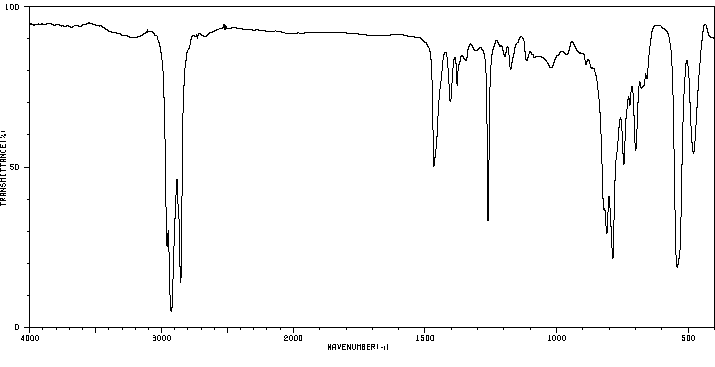甲基癸基二氯硅烷 | 18051-88-2
中文名称
甲基癸基二氯硅烷
中文别名
癸基甲基二氯硅烷;二氯烷基甲基硅烷
英文名称
dichloro(decyl)(methyl)silane
英文别名
dichloro(decyl)methylsilane;decylmethyldichlorosilane;dichloro-decyl-methyl-silane;Dichlor-decyl-methyl-silan;Methyl-decyl-dichlor-silan;Silane, dichlorodecylmethyl-;dichloro-decyl-methylsilane
CAS
18051-88-2
化学式
C11H24Cl2Si
mdl
MFCD00053194
分子量
255.303
InChiKey
UFVFNJHZBMHRCO-UHFFFAOYSA-N
BEILSTEIN
——
EINECS
——
-
物化性质
-
计算性质
-
ADMET
-
安全信息
-
SDS
-
制备方法与用途
-
上下游信息
-
文献信息
-
表征谱图
-
同类化合物
-
相关功能分类
-
相关结构分类
物化性质
-
熔点:<0°C
-
沸点:111 °C
-
密度:0.96
-
闪点:120°C
计算性质
-
辛醇/水分配系数(LogP):4.84
-
重原子数:14
-
可旋转键数:9
-
环数:0.0
-
sp3杂化的碳原子比例:1.0
-
拓扑面积:0
-
氢给体数:0
-
氢受体数:0
安全信息
-
TSCA:Yes
-
危险等级:8
-
安全说明:S26,S36/37/39
-
危险类别码:R34
-
危险品运输编号:2987
-
包装等级:II
-
危险类别:8
-
危险性防范说明:P280,P390,P303+P361+P353,P301+P330+P331,P304+P340+P310,P305+P351+P338+P310
-
危险性描述:H290,H314
-
储存条件:存放于惰性气体中;避免光照和潮湿(否则会分解)。
SDS
甲基癸基二氯硅烷 修改号码:2
模块 1. 化学品
产品名称: Dichlorodecylmethylsilane
修改号码: 2
模块 2. 危险性概述
GHS分类
物理性危害
金属腐蚀性 第1级
健康危害
皮肤腐蚀/刺激 1B类
严重损伤/刺激眼睛 第1级
环境危害 未分类
GHS标签元素
图标或危害标志
信号词 危险
危险描述 可能腐蚀金属
造成严重的皮肤灼伤和眼损伤
防范说明
[预防] 只可存放于原用的容器内。
切勿吸入。
处理后要彻底清洗双手。
穿戴防护手套/护目镜/防护面具。
[急救措施] 吸入:将受害者移到新鲜空气处,在呼吸舒适的地方保持休息。
食入:漱口。切勿催吐。
眼睛接触:用水小心清洗几分钟。如果方便,易操作,摘除隐形眼镜。继续冲洗。
皮肤接触:立即去除/脱掉所有被污染的衣物。用水清洗皮肤/淋浴。
被污染的衣物清洗后方可重新使用。
立即呼叫解毒中心/医生。
吸收溢出物,防止材料被损坏。
[储存] 存放处须加锁。
[废弃处置] 根据当地政府规定把物品/容器交与工业废弃处理机构。
甲基癸基二氯硅烷 修改号码:2
模块 3. 成分/组成信息
单一物质/混和物 单一物质
化学名(中文名): 甲基癸基二氯硅烷
百分比: >97.0%(GC)
CAS编码: 18051-88-2
俗名: Decylmethyldichlorosilane
分子式: C11H24Cl2Si
模块 4. 急救措施
吸入: 将受害者移到新鲜空气处,保持呼吸通畅,休息。立即呼叫解毒中心/医生。
皮肤接触: 立即去除/脱掉所有被污染的衣物。用大量肥皂和水轻轻洗。
立即呼叫解毒中心/医生。
眼睛接触: 用水小心清洗几分钟。如果方便,易操作,摘除隐形眼镜。继续清洗。
立即呼叫解毒中心/医生。
食入: 立即呼叫解毒中心/医生。漱口。切勿引吐。
紧急救助者的防护: 救援者需要穿戴个人防护用品,比如橡胶手套和气密性护目镜。
模块 5. 消防措施
合适的灭火剂: 干粉,二氧化碳
不适用的灭火剂: 水
特殊危险性: 小心,燃烧或高温下可能分解产生毒烟。
特定方法: 从上风处灭火,根据周围环境选择合适的灭火方法。
非相关人员应该撤离至安全地方。
周围一旦着火:如果安全,移去可移动容器。
消防员的特殊防护用具: 灭火时,一定要穿戴个人防护用品。
模块 6. 泄漏应急处理
个人防护措施,防护用具, 使用特殊的个人防护用品(自携式呼吸器)。远离溢出物/泄露处并处在上风处。确保
紧急措施: 足够通风。
泄露区应该用安全带等圈起来,控制非相关人员进入。
环保措施: 防止进入下水道。
控制和清洗的方法和材料: 用合适的吸收剂(如:旧布,干砂,土,锯屑)吸收泄漏物。一旦大量泄漏,筑堤控
制。附着物或收集物应该立即根据合适的法律法规废弃处置。
副危险性的防护措施 切勿与水接触。移除所有火源。一旦发生火灾应该准备灭火器。使用防火花工具和防
爆设备。
模块 7. 操作处置与储存
处理
技术措施: 在通风良好处进行处理。穿戴合适的防护用具。防止烟雾产生。处理后彻底清洗双手
和脸。
注意事项: 如果可能,使用封闭系统。如果蒸气或浮质产生,使用通风、局部排气。
操作处置注意事项: 避免接触皮肤、眼睛和衣物。
可能产生高压。小心打开。
使用耐腐蚀设备。
贮存
储存条件: 保持容器密闭。存放于凉爽、阴暗处。
存放于惰性气体环境中。
防湿。
存放处须加锁。
远离不相容的材料比如氧化剂存放。
甲基癸基二氯硅烷 修改号码:2
模块 7. 操作处置与储存
包装材料: 依据法律。只可存放在原用的容器內。
模块 8. 接触控制和个体防护
工程控制: 尽可能安装封闭体系或局部排风系统。同时安装淋浴器和洗眼器。
个人防护用品
呼吸系统防护: 半面罩或全面罩呼吸器,自携式呼吸器(SCBA),供气呼吸器等。依据当地和政府法
规,使用通过政府标准的呼吸器。
手部防护: 防渗手套。
眼睛防护: 护目镜。如果情况需要,佩戴面具。
皮肤和身体防护: 防渗防护服。如果情况需要,穿戴防护靴。
模块 9. 理化特性
液体
外形(20°C):
外观: 透明
颜色: 无色-微浅黄色
气味: 无资料
pH: 无数据资料
熔点: 无资料
沸点/沸程 129 °C/0.7kPa
闪点: 120°C
爆炸特性
爆炸下限: 1.1%
爆炸上限: 无资料
蒸气密度: >1
密度: 0.96
溶解度: 无资料
模块 10. 稳定性和反应性
稳定性: 一般情况下稳定。
反应性: 与水接触分解并产生有毒气体。
避免接触的条件: 光敏, 潮敏
须避免接触的物质 氧化剂
危险的分解产物: 一氧化碳, 二氧化碳, 氯化氢, 氧化硅
模块 11. 毒理学信息
急性毒性: 无资料
对皮肤腐蚀或刺激: 无资料
对眼睛严重损害或刺激: 无资料
生殖细胞变异原性: 无资料
致癌性:
IARC = 无资料
NTP = 无资料
生殖毒性: 无资料
模块 12. 生态学信息
生态毒性:
鱼类: 无资料
甲壳类: 无资料
藻类: 无资料
残留性 / 降解性: 无资料
甲基癸基二氯硅烷 修改号码:2
模块 12. 生态学信息
潜在生物累积 (BCF): 无资料
土壤中移动性
log水分配系数: 无资料
土壤吸收系数 (Koc): 无资料
亨利定律 无资料
constaNT(PaM3/mol):
模块 13. 废弃处置
如果可能,回收处理。请咨询当地管理部门。建议在装有后燃和洗涤装置的化学焚烧炉中焚烧。废弃处置时请遵守
国家、地区和当地的所有法规。
模块 14. 运输信息
联合国分类: 第8类 腐蚀品
UN编号: 2987
正式运输名称: 氯硅烷, 腐蚀的, 不另作详细说明
包装等级: II
模块 15. 法规信息
《危险化学品安全管理条例》(2002年1月26日国务院发布): 针对危险化学品的安全使用、生产、储存、运输、装
卸等方面均作了相应的规定。
模块16 - 其他信息
N/A
模块 1. 化学品
产品名称: Dichlorodecylmethylsilane
修改号码: 2
模块 2. 危险性概述
GHS分类
物理性危害
金属腐蚀性 第1级
健康危害
皮肤腐蚀/刺激 1B类
严重损伤/刺激眼睛 第1级
环境危害 未分类
GHS标签元素
图标或危害标志
信号词 危险
危险描述 可能腐蚀金属
造成严重的皮肤灼伤和眼损伤
防范说明
[预防] 只可存放于原用的容器内。
切勿吸入。
处理后要彻底清洗双手。
穿戴防护手套/护目镜/防护面具。
[急救措施] 吸入:将受害者移到新鲜空气处,在呼吸舒适的地方保持休息。
食入:漱口。切勿催吐。
眼睛接触:用水小心清洗几分钟。如果方便,易操作,摘除隐形眼镜。继续冲洗。
皮肤接触:立即去除/脱掉所有被污染的衣物。用水清洗皮肤/淋浴。
被污染的衣物清洗后方可重新使用。
立即呼叫解毒中心/医生。
吸收溢出物,防止材料被损坏。
[储存] 存放处须加锁。
[废弃处置] 根据当地政府规定把物品/容器交与工业废弃处理机构。
甲基癸基二氯硅烷 修改号码:2
模块 3. 成分/组成信息
单一物质/混和物 单一物质
化学名(中文名): 甲基癸基二氯硅烷
百分比: >97.0%(GC)
CAS编码: 18051-88-2
俗名: Decylmethyldichlorosilane
分子式: C11H24Cl2Si
模块 4. 急救措施
吸入: 将受害者移到新鲜空气处,保持呼吸通畅,休息。立即呼叫解毒中心/医生。
皮肤接触: 立即去除/脱掉所有被污染的衣物。用大量肥皂和水轻轻洗。
立即呼叫解毒中心/医生。
眼睛接触: 用水小心清洗几分钟。如果方便,易操作,摘除隐形眼镜。继续清洗。
立即呼叫解毒中心/医生。
食入: 立即呼叫解毒中心/医生。漱口。切勿引吐。
紧急救助者的防护: 救援者需要穿戴个人防护用品,比如橡胶手套和气密性护目镜。
模块 5. 消防措施
合适的灭火剂: 干粉,二氧化碳
不适用的灭火剂: 水
特殊危险性: 小心,燃烧或高温下可能分解产生毒烟。
特定方法: 从上风处灭火,根据周围环境选择合适的灭火方法。
非相关人员应该撤离至安全地方。
周围一旦着火:如果安全,移去可移动容器。
消防员的特殊防护用具: 灭火时,一定要穿戴个人防护用品。
模块 6. 泄漏应急处理
个人防护措施,防护用具, 使用特殊的个人防护用品(自携式呼吸器)。远离溢出物/泄露处并处在上风处。确保
紧急措施: 足够通风。
泄露区应该用安全带等圈起来,控制非相关人员进入。
环保措施: 防止进入下水道。
控制和清洗的方法和材料: 用合适的吸收剂(如:旧布,干砂,土,锯屑)吸收泄漏物。一旦大量泄漏,筑堤控
制。附着物或收集物应该立即根据合适的法律法规废弃处置。
副危险性的防护措施 切勿与水接触。移除所有火源。一旦发生火灾应该准备灭火器。使用防火花工具和防
爆设备。
模块 7. 操作处置与储存
处理
技术措施: 在通风良好处进行处理。穿戴合适的防护用具。防止烟雾产生。处理后彻底清洗双手
和脸。
注意事项: 如果可能,使用封闭系统。如果蒸气或浮质产生,使用通风、局部排气。
操作处置注意事项: 避免接触皮肤、眼睛和衣物。
可能产生高压。小心打开。
使用耐腐蚀设备。
贮存
储存条件: 保持容器密闭。存放于凉爽、阴暗处。
存放于惰性气体环境中。
防湿。
存放处须加锁。
远离不相容的材料比如氧化剂存放。
甲基癸基二氯硅烷 修改号码:2
模块 7. 操作处置与储存
包装材料: 依据法律。只可存放在原用的容器內。
模块 8. 接触控制和个体防护
工程控制: 尽可能安装封闭体系或局部排风系统。同时安装淋浴器和洗眼器。
个人防护用品
呼吸系统防护: 半面罩或全面罩呼吸器,自携式呼吸器(SCBA),供气呼吸器等。依据当地和政府法
规,使用通过政府标准的呼吸器。
手部防护: 防渗手套。
眼睛防护: 护目镜。如果情况需要,佩戴面具。
皮肤和身体防护: 防渗防护服。如果情况需要,穿戴防护靴。
模块 9. 理化特性
液体
外形(20°C):
外观: 透明
颜色: 无色-微浅黄色
气味: 无资料
pH: 无数据资料
熔点: 无资料
沸点/沸程 129 °C/0.7kPa
闪点: 120°C
爆炸特性
爆炸下限: 1.1%
爆炸上限: 无资料
蒸气密度: >1
密度: 0.96
溶解度: 无资料
模块 10. 稳定性和反应性
稳定性: 一般情况下稳定。
反应性: 与水接触分解并产生有毒气体。
避免接触的条件: 光敏, 潮敏
须避免接触的物质 氧化剂
危险的分解产物: 一氧化碳, 二氧化碳, 氯化氢, 氧化硅
模块 11. 毒理学信息
急性毒性: 无资料
对皮肤腐蚀或刺激: 无资料
对眼睛严重损害或刺激: 无资料
生殖细胞变异原性: 无资料
致癌性:
IARC = 无资料
NTP = 无资料
生殖毒性: 无资料
模块 12. 生态学信息
生态毒性:
鱼类: 无资料
甲壳类: 无资料
藻类: 无资料
残留性 / 降解性: 无资料
甲基癸基二氯硅烷 修改号码:2
模块 12. 生态学信息
潜在生物累积 (BCF): 无资料
土壤中移动性
log水分配系数: 无资料
土壤吸收系数 (Koc): 无资料
亨利定律 无资料
constaNT(PaM3/mol):
模块 13. 废弃处置
如果可能,回收处理。请咨询当地管理部门。建议在装有后燃和洗涤装置的化学焚烧炉中焚烧。废弃处置时请遵守
国家、地区和当地的所有法规。
模块 14. 运输信息
联合国分类: 第8类 腐蚀品
UN编号: 2987
正式运输名称: 氯硅烷, 腐蚀的, 不另作详细说明
包装等级: II
模块 15. 法规信息
《危险化学品安全管理条例》(2002年1月26日国务院发布): 针对危险化学品的安全使用、生产、储存、运输、装
卸等方面均作了相应的规定。
模块16 - 其他信息
N/A
上下游信息
-
下游产品
中文名称 英文名称 CAS号 化学式 分子量 癸基二甲基氯硅烷 chloro(decyl)dimethylsilane 38051-57-9 C12H27ClSi 234.885
反应信息
-
作为反应物:参考文献:名称:设计的具有烷基链的低聚硅氧烷自组装成基于二氧化硅的混合介观结构摘要:已经研究了使用具有烷氧基官能团和共价连接的烷基链的明确定义的硅氧烷低聚物来制备有序二氧化硅-有机杂化物的新型自组装途径。在不使用任何结构导向剂的情况下,通过水解和缩聚获得了各种混合介观结构。具有烷基硅烷核和三个支链三甲氧基甲硅烷基的低聚物 1(Cn) 在 n = 14-18 时形成高度有序的层状相,而那些具有较短烷基链的低聚物形成圆柱形组件,略微扭曲的二维 (2D) 六边形结构( n = 6-10),以及一种新颖的二维单斜结构(n = 12)。此外,具有不同链长的 1(Cn) 的混合物产生了有序的二维六方相,这可能是由于前体更好的堆积。在煅烧以去除有机基团时,由圆柱形组件组成的杂化物被转化为具有可调孔径的有序多孔二氧化硅。1(Cn) 的水解和缩聚过程的液态 29Si NMR 分析揭示了一种独特的分子内反应,主要产生具有四硅氧烷环的低聚物,这是一类具有自组装能力和高交联性的新型两亲分子能力。DOI:10.1021/ja0541736
-
作为产物:参考文献:名称:1,1,1-三氯-2-溴丙烯的均相异构化摘要:(1)已显示1,1,1,1-三氯-2-溴丙烯在紫外线照射下会同质异构化,形成1,1,2-三氯-3-溴丙烯,并在五氯化锑的作用下杂化生成1,1,3-三氯-2-溴丙烯DOI:10.1016/0040-4020(57)88045-4
文献信息
-
Catalytic Synthesis of Functional Silicon-Stereogenic Silanes through<i>Candida antarctica</i>Lipase B Catalyzed Remote Desymmetrization of Silicon-Centered Diols作者:Xing Lu、Li Li、Wei Yang、Kezhi Jiang、Ke-Fang Yang、Zhan-Jiang Zheng、Li-Wen XuDOI:10.1002/ejoc.201300932日期:2013.9A series of silicon-containing diols are synthesized and used in lipase-catalyzed remote desymmetrization. This synthetic method is valuable in the construction of optically active silicon-stereogenic organosilicon compounds. Good enantioselectivities of the remote desymmetrization was achieved with Candida antarctica lipase B (CAL-B) (up to 90:10er).
-
A General and Selective Synthesis of Methylmonochlorosilanes from Di-, Tri-, and Tetrachlorosilanes作者:Yuki Naganawa、Kei Sakamoto、Yumiko NakajimaDOI:10.1021/acs.orglett.0c04175日期:2021.1.15Direct catalytic transformation of chlorosilanes into organosilicon compounds remains challenging due to difficulty in cleaving the strong Si–Cl bond(s). We herein report the palladium-catalyzed cross-coupling reaction of chlorosilanes with organoaluminum reagents. A combination of [Pd(C3H5)Cl]2 and DavePhos ligand catalyzed the selective methylation of various dichlorosilanes 1, trichlorosilanes 5
-
Preparation of polycarboxylic acid-functionalized silica supported Pt catalysts and their applications in alkene hydrosilylation作者:Dongyun Shao、Youxin LiDOI:10.1039/c8ra01828f日期:——(AAS). The residual H2PtCl6 solutions were characterized using ultraviolet spectroscopy (UV). The polycarboxylic acid-functionalized silica supported Pt catalysts were used to catalyze alkene hydrosilylation and 1-hexene was chosen as a model alkene. The data indicated that the catalytic performance was strongly dependent on the properties of the polycarboxylic acid group bonded to the silica particles通过将 Pt 负载到二亚乙基三胺五乙酸 (DTPA)、硝基三乙酸 (NTA) 和琥珀酸 (SA) 等多元羧酸基团修饰的二氧化硅颗粒上,制备了一系列新型固定铂催化剂。使用红外光谱 (IR)、透射电子显微镜 (TEM)、X 射线光电子能谱 (XPS)、能量色散 X 射线光谱 (EDS) 和原子吸收光谱 (AAS) 对三种改性非均相 Pt 催化剂进行了表征。残留的 H 2 PtCl 6使用紫外光谱 (UV) 对溶液进行表征。多元羧酸官能化二氧化硅负载的 Pt 催化剂用于催化烯烃氢化硅烷化,并选择 1-己烯作为模型烯烃。数据表明催化性能强烈依赖于键合到二氧化硅颗粒上的多元羧酸基团的性质。其中,DTPA功能化二氧化硅负载的Pt(SiO 2 -DTPA-Pt)表现出最好的催化活性和可重复使用性。此外,其他线性烯烃(1-庚烯、1-辛烯、1-癸烯、1-十二碳烯、1-十四碳烯、1-六碳烯、1-八碳烯、苯乙烯
-
안트라센 유도체 및 이를 이용한 유기 발광 소자
-
Fabrication of Fluorescent Silica Nanoparticles Hybridized with AIE Luminogens and Exploration of Their Applications as Nanobiosensors in Intracellular Imaging作者:Mahtab Faisal、Yuning Hong、Jianzhao Liu、Yong Yu、Jacky W. Y. Lam、Anjun Qin、Ping Lu、Ben Zhong TangDOI:10.1002/chem.200901823日期:2010.4.12Highly emissive inorganic–organic nanoparticles with core–shell structures are fabricated by a one‐pot, surfactant‐free hybridization process. The surfactant‐free sol–gel reactions of tetraphenylethene‐ (TPE) and silole‐functionalized siloxanes followed by reactions with tetraethoxysilane afford fluorescent silica nanoparticles FSNP‐1 and FSNP‐2, respectively. The FSNPs are uniformly sized, surface‐charged
表征谱图
-
氢谱1HNMR
-
质谱MS
-
碳谱13CNMR
-
红外IR
-
拉曼Raman
-
峰位数据
-
峰位匹配
-
表征信息
同类化合物
(2-溴乙氧基)-特丁基二甲基硅烷
鲸蜡基聚二甲基硅氧烷
骨化醇杂质DCP
马沙骨化醇中间体
马来酸双(三甲硅烷)酯
顺式-二氯二(二甲基硒醚)铂(II)
顺-N-(1-(2-乙氧基乙基)-3-甲基-4-哌啶基)-N-苯基苯酰胺
降钙素杂质13
降冰片烯基乙基三甲氧基硅烷
降冰片烯基乙基-POSS
间-氨基苯基三甲氧基硅烷
镓,二(1,1-二甲基乙基)甲基-
镁,氯[[二甲基(1-甲基乙氧基)甲硅烷基]甲基]-
锑,二溴三丁基-
铷,[三(三甲基甲硅烷基)甲基]-
铂(0)-1,3-二乙烯-1,1,3,3-四甲基二硅氧烷
钾(4-{[二甲基(2-甲基-2-丙基)硅烷基]氧基}-1-丁炔-1-基)(三氟)硼酸酯(1-)
金刚烷基乙基三氯硅烷
酰氧基丙基双封头
达格列净杂质
辛醛,8-[[(1,1-二甲基乙基)二甲基甲硅烷基]氧代]-
辛甲基-1,4-二氧杂-2,3,5,6-四硅杂环己烷
辛基铵甲烷砷酸盐
辛基衍生化硅胶(C8)ZORBAX?LP100/40C8
辛基硅三醇
辛基甲基二乙氧基硅烷
辛基三甲氧基硅烷
辛基三氯硅烷
辛基(三苯基)硅烷
辛乙基三硅氧烷
路易氏剂-3
路易氏剂-2
路易士剂
试剂Cyanomethyl[3-(trimethoxysilyl)propyl]trithiocarbonate
试剂3-[Tris(trimethylsiloxy)silyl]propylvinylcarbamate
试剂3-(Trimethoxysilyl)propylvinylcarbamate
试剂2-(Trimethylsilyl)cyclopent-2-en-1-one
试剂11-Azidoundecyltriethoxysilane
西甲硅油杂质14
衣康酸二(三甲基硅基)酯
苯胺,4-[2-(三乙氧基甲硅烷基)乙基]-
苯磺酸,羟基-,盐,单钠聚合甲醛,1,3,5-三嗪-2,4,6-三胺和脲
苯甲醇,a-[(三苯代甲硅烷基)甲基]-
苯并磷杂硅杂英,5,10-二氢-10,10-二甲基-5-苯基-
苯基二甲基氯硅烷
苯基二甲基乙氧基硅
苯基二甲基(2'-甲氧基乙氧基)硅烷
苯基乙酰氧基三甲基硅烷
苯基三辛基硅烷
苯基三甲氧基硅烷










